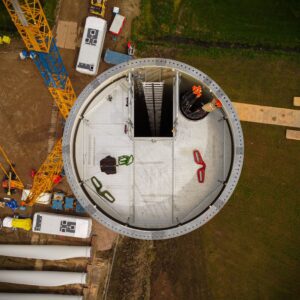As an industry professional, you understand the importance of optimal storage solutions. Aboveground Storage tank provides Industry Solution for Storage Needs. Aboveground storage tanks have emerged as a key asset for companies aiming to safely and cost-effectively store materials. Their versatility and customization allow for diverse applications across sectors. Whether for the petrochemical, mining, or agriculture industries, aboveground tanks provide an array of benefits over other options.
Aboveground tanks have become an industry solution for storage needs due to their durability, regulatory compliance, and space-efficiency. Their design and construction adhere to strict safety and environmental standards to ensure secure containment. They also optimize available space by allowing for vertical storage. As companies increasingly demand innovative and sustainable storage options, aboveground tanks stand out with their functionality, adaptability, and compliance. For industry leaders seeking the latest in storage technology, aboveground tanks warrant consideration as an investment in operational excellence and responsible environmental stewardship.
The Rise of Aboveground Tanks in Industrial Applications
The rise of aboveground storage tanks (ASTs) as a solution for industrial storage needs has steadily climbed over the past several decades. ASTs provide a safe, cost-efficient, and regulatory-compliant means of storing hazardous and non-hazardous liquids.
The ASTs offer many benefits over underground storage tanks (USTs). They are easier to install and maintain since they are accessible above ground. They also allow for visual inspections and monitoring to promptly identify any leaks or damage. This results in reduced environmental risk and liability. ASTs are also often more affordable to construct and repair or replace.
The most common materials for ASTs are carbon steel, stainless steel, and polyethylene or fiberglass reinforced plastic (FRP). Carbon steel and stainless steel ASTs provide exceptional strength and durability but often require protective coatings to prevent corrosion. Polyethylene and FRP ASTs are resistant to both corrosion and chemicals but may have lower pressure tolerances. The material selected depends on factors like the properties of the stored liquid, desired tank life, and cost.
Industries frequently use ASTs to store raw materials, finished products, wastewater, chemicals, solvents, and petroleum products. Typical capacities range from 5,000 to over 50,000 gallons for a single AST. AST farms, or tank battery sites, allow for storage of higher volumes across multiple ASTs.
With a proven track record of safety, reliability and regulatory compliance, ASTs have solidified their role as a go-to solution for industrial storage needs. Advancements in AST design, materials, and containment have made them well-suited to handle the demanding requirements of industry applications. For companies seeking cost-effective, responsibly-managed storage, ASTs offer an ideal solution.
Benefits of Aboveground Tanks for Storage
Aboveground storage tanks offer many benefits for industrial storage needs.
Cost-Effective Storage
Aboveground tanks are often cheaper to install and maintain compared to underground tanks. They do not require the expensive excavation, pipe trenching, and installation needed for underground tanks. Aboveground tanks also provide easier access for inspection, repair, and replacement, reducing maintenance costs.
Regulatory Compliance
Aboveground storage tanks meet regulatory requirements more readily. They can be installed without disturbing the surrounding environment or infrastructure. Compliance with environmental regulations like Leakage prevention is more straightforward. Monitoring and leak detection systems can be more easily installed and accessed.
Versatile Storage
Aboveground tanks come in a range of fuel storage tanks sizes to suit different storage needs. They can hold thousands of gallons for large-scale industrial use or a few hundred gallons for smaller commercial purposes. They are also compatible with a variety of substances from water and chemicals to petroleum products and waste materials.
Safety
Properly designed aboveground storage tanks have built-in secondary containment systems to prevent spills and leaks. They also allow for visual inspections to check for damage or leaks, ensuring safer storage. The contents are more easily accessed in case of emergencies. Warning and safety signage can be clearly displayed on aboveground tanks.
Flexibility
You can relocate aboveground tanks if needed to suit changing business requirements or safety standards. They offer flexible storage that you can scale up or down and reconfigure as needed. Aboveground tanks are a adaptable solution for storage needs.
In summary, aboveground storage tanks offer cost-effective, regulatory-compliant, versatile and safe storage for a range of industrial needs. They provide flexibility to adapt to operational changes efficiently and economically. For these reasons, aboveground tanks have become key assets for industrial storage solutions.
Common Industrial Uses of Aboveground Tanks
Aboveground storage tanks have become integral assets for industrial storage solutions. They are commonly used for:
Fuel Storage Tanks
Industries frequently use aboveground storage tanks for fuel often called ASTs, to store large volumes of fuels like diesel, gasoline, kerosene, and aviation fuel. Some facilities keep ASTs onsite to refuel vehicles, generators and machinery. Others use them as a bulk storage solution, holding thousands of gallons of fuel that is then distributed to end users.
Chemical Storage Tanks
The chemical industry relies heavily on aboveground tanks for storing raw materials, intermediate products and end products. ASTs made of specialized alloys that can withstand corrosive chemicals are often required. Double-walled ASTs with monitoring systems provide an added level of safety and environmental protection.
Water Storage Tanks
Access to reliable water sources is essential for many industrial operations. Factories, mills, mines, and other facilities use aboveground water tanks to store fresh water for various purposes such as production processes, sanitation, and fire suppression systems. They also use these tanks to store wastewater, chemicals, or other liquids onsite before treatment or disposal.
Temporary Storage Tanks
Mobile aboveground storage tanks on trailers provide temporary storage solutions for industries. People often use tanks at construction sites, disaster relief sites, military operations or for events. They can transport the tanks to locations where storage is needed, and then remove them when no longer required. Some people also use mobile tanks to transport liquids between locations.
Proper use and maintenance of aboveground storage tanks help ensure safe, responsible and sustainable industrial operations. ASTs must meet strict structural, containment and monitoring requirements to prevent leaks, spills and other environmental damage. When selecting ASTs, consider size, material, secondary containment, alarms and instrumentation needed for your specific storage application. Regular inspections, testing and training also help minimize risks associated with aboveground tank storage.
Conclusion
As you consider your company’s storage needs, aboveground tanks should be at the top of your list of solutions. They offer durability, versatility, and compliance benefits that will serve your operations well for decades. While underground storage tanks have been an industry standard for years, aboveground tanks eliminate the risks and liabilities of underground spills and leaks. They also provide more flexibility in changing site conditions and storage needs.
The range of available tank sizes, materials, and accessories means there is an aboveground storage tank option for any commercial or industrial need. Protecting the health and safety of communities and the environment should be a top priority for any organization. Aboveground storage tanks are an investment in responsible business practices that also make economic sense. Look to industry leaders with decades of experience in manufacturing, installing, and maintaining aboveground tanks. They have the expertise to help determine and provide the best solution for your storage demands.
Aboveground tanks are the clear path forward for companies ready to upgrade their storage infrastructure. Take the opportunity now to establish an environmentally-friendly and operationally-efficient storage system that will serve you well into the future. Your business and community will benefit from this forward-thinking decision for years to come.




